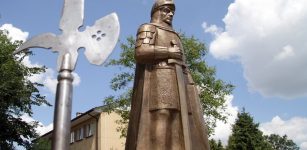Dozens Of Giant ‘Lost’ Nazca Geoglyphs Unearthed By Drones In Peru
AncientPages.com - There seems to be no ending to the amount of Nazca geoglyphs. As many as 50 giants figures have been unearthed by drones, Peruvian archaeologists report.
Stretching across nearly 200 square miles of high arid plateau the Nazca lines are legendary and of great interest to archaeologists and historians.
Not long ago, archaeologists discovered a giant Orca geoglyph along with mysterious symbols and a ‘trophy head’.
Now National Geographic reports dozens of new geoglyphs are clearly visible from the air and some of them are among the oldest yet found.
Ancient Peruvians created geoglyphs like the Nasca lines by moving stones to define edges of the lines, and then scraping the top layer of earth between the edges to reveal lighter soil beneath. ART BY FERNANDO G. BAPTISTA/NGM STAFF SOURCE: MARKUS REINDEL, GERMAN ARCHAEOLOGICAL INSTITUT. Courtesy National Geographic
Using high-resolution camera equipped drones, archaeologists mapped the desert site and found figures that are almost invisible to the naked eye.
These geoglyphs have been heavily worn down over the ages and their remains are etched only lightly into the ground.
“Most of these figures are warriors,” says Peruvian archaeologist Luis Jaime Castillo Butters, the new glyphs' co-discoverer. “These ones could be spotted from a certain distance, so people had seen them, but over time, they were completely erased.”
Many of the geoglyphs were created by the Nazca culture that lived in the region between 200 and 700 A.D, but archaeologists suspect the new images are much older, dating from between 500BC and 200AD. This places them at the hands of the earlier Paracas and Topara cultures.
The Paracas people preferred to place its stone monuments on the side of hills, National Geographic reports, enabling them to be seen from the villages below.
The Nazca people,on the other hand, put their stone lines mostly on flat ground, where their full form could only be seen from the sky.
PHOTOGRAPH COURTESY LUIS JAIME CASTILLO, PALPA NASCA PROJECT
And where the Nazca works consist mostly of lines and polygons, the Paracas people generally traced the human form.
Centuries before the famous Nazca lines were made, people in the region were experimenting with making massive geoglyphs.
See also:
Astonishing Pre-Inca Salt Ponds of Maras In Peru Were Created By The Chanapata Culture
First Settlers Of Ancient Peru Left Behind 12,000-Year-Old Stone Objects
Ancient Cranial Modification In Peru Led To Social Inequality
“This means that it is a tradition of over a thousand years that precedes the famous geoglyphs of the Nasca culture, which opens the door to new hypotheses about its function and meaning,” says Peruvian Ministry of Culture archaeologist Johny Isla, the Nasca lines' chief restorer and protector.
It’s worth mentioning that the enigmatic Palpa lines in Peru are not as famous as the Nazca lines, but these puzzling lines and geoglyphs that can only be properly viewed from the air are equally interesting and they are much older than the Nazca geoglyphs.
AncientPages.com






















